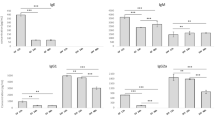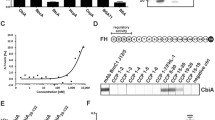Abstract
The critical role of IgM in controlling pathogen burden has been demonstrated in a variety of infection models. In the murine model of Borrelia hermsii infection, IgM is necessary and sufficient for the rapid clearance of bacteremia. Convalescent, but not naïve, B1b cells generate a specific IgM response against B. hermsii, but the mechanism of IgM-mediated protection is unknown. Here, we show that neither Fcα/μR, a high-affinity receptor for IgM, nor IgM-dependent complement activation is required for controlling B. hermsii. Bacteria in diffusion chambers with a pore size impermeable to cells were killed when diffusion chambers were implanted into either convalescent or passively immunized mice. Furthermore, adoptively transferred convalescent B1b cells in Rag1−/− mice produced specific IgM that also cleared B. hermsii in diffusion chambers independent of complement. These results demonstrate that IgM-mediated clearance of B. hermsii does not require opsonophagocytosis and indicate that a mechanism for in vivo B1b cell-mediated protection is through the generation of bactericidal IgM.





Similar content being viewed by others
References
Ochsenbein AF, et al. Control of early viral and bacterial distribution and disease by natural antibodies. Science. 1999;286:2156–9.
Boes M. Role of natural and immune IgM antibodies in immune responses. Mol Immunol. 2000;37(18):1141–9.
Baumgarth N, et al. B-1 and B-2 cell-derived immunoglobulin M antibodies are nonredundant components of the protective response to influenza virus infection. J Exp Med. 2000;192:271–80.
Haas KM, et al. B-1a and B-1b cells exhibit distinct developmental requirements and have unique functional roles in innate and adaptive immunity to S. pneumoniae. Immunity. 2005;23(1):7–18.
Connolly SE, Benach JL. The versatile roles of antibodies in Borrelia infections. Nat Rev Microbiol. 2005;3(5):411–20.
Alugupalli KR. A distinct role for B1b lymphocytes in T cell-independent immunity. Curr Top Microbiol Immunol. 2008;319:105–30.
Southern PM Jr, Sanford J. Relapsing Fever-A clinical and microbiological review. Medicine. 1969;48:129–49.
Barbour AG. Antigenic variation of a relapsing fever Borrelia species. Annu Rev Microbiol. 1990;44:155–71.
Arimitsu Y, Akama K. Characterization of protective antibodies produced in mice infected with Borrelia duttonii. Jpn J Med Sci Biol. 1973;26:229–37.
Newman K Jr, Johnson RC. T-cell-independent elimination of Borrelia turicatae. Infect Immun. 1984;45:572–6.
Yokota M, et al. Protective activity of Borrelia duttonii-specific immunoglobulin subclasses in mice. J Med Microbiol. 1997;46:675–80.
Barbour AG, Bundoc V. In vitro and in vivo neutralization of the relapsing fever agent Borrelia hermsii with serotype-specific immunoglobulin M antibodies. Infect Immun. 2001;69:1009–15.
Connolly SE, Benach JL. The spirochetemia of murine relapsing fever is cleared by complement-independent bactericidal antibodies. J Immunol. 2001;167:3029–32.
Alugupalli KR, et al. The resolution of relapsing fever Borreliosis requires IgM and is concurrent with expansion of B1b lymphocytes. J Immunol. 2003;170:3819–27.
Alugupalli KR, et al. B1b Lymphocytes confer T cell-independent long-lasting immunity. Immunity. 2004;21:379–90.
Colombo MJ, Alugupalli KR. Complement factor H-binding protein, a putative virulence determinant of Borrelia hermsii, is an antigenic target for protective B1b lymphocytes. J Immunol. 2008;180(7):4858–64.
Newman K Jr, Johnson RC. In vivo evidence that an intact lytic complement pathway is not essential for successful removal of circulating Borrelia turicatae from mouse blood. Infect Immun. 1981;31(1):465–9.
Connolly SE, Thanassi DG, Benach JL. Generation of a complement-independent bactericidal IgM against a relapsing fever Borrelia. J Immunol. 2004;172:1191–7.
Shibuya A, et al. Fc a/m receptor mediates endocytosis of IgM-coated microbes. Nat Immunol. 2000;1:441–6.
Honda S, et al. Enhanced humoral immune responses against T-independent antigens in Fc alpha/muR-deficient mice. Proc Natl Acad Sci USA. 2009;106(27):11230–5.
Kurita N, et al. Identification of the Fcalpha/muR isoform specifically expressed in the kidney tubules. Mol Immunol. 2009;46(4):749–53.
Spagnuolo PJ, et al. Opsonic requirements for phagocytosis of Borrelia hermsii by human polymorphonuclear leukocytes. J Infect Dis. 1982;145(3):358–64.
Wentworth AD, et al. Antibodies have the intrinsic capacity to destroy antigens. Proc Natl Acad Sci USA. 2000;97:10930–5.
Wentworth P Jr, et al. Evidence for antibody-catalyzed ozone formation in bacterial killing and inflammation. Science. 2002;298(5601):2195–9.
Wentworth P Jr, et al. Antibody catalysis of the oxidation of water. Science. 2001;293(5536):1806–11.
Rogers HJ. Ferric iron and the antibacterial effects of horse 7S antibodies to Escherichia coli O111. Immunology. 1976;30(3):425–33.
Rogers HJ, Synge C. Bacteriostatic effect of human milk on Escherichia coli: the role of IgA. Immunology. 1978;34(1):19–28.
LaRocca TJ, et al. Bactericidal action of a complement-independent antibody against relapsing fever Borrelia resides in its variable region. J Immunol. 2008;180(9):6222–8.
Van den Berg CW, Aerts PC, Van Dijk H. In vivo anti-complementary activities of the cobra venom factors from Naja naja and Naja haje. J Immunol Methods. 1991;136(2):287–94.
Szalai AJ, Briles DE, Volanakis JE. Role of complement in C-reactive-protein-mediated protection of mice from Streptococcus pneumoniae. Infect Immun. 1996;64(11):4850–3.
Abraham D, et al. Strongyloides stercoralis: protective immunity to third-stage larvae inBALB/cByJ mice. Exp Parasitol. 1995;80(2):297–307.
Xie X, McLean MD, Hall JC. Antibody-dependent cell-mediated cytotoxicity- and complement-dependent cytotoxicity-independent bactericidal activity of an IgG against Pseudomonas aeruginosa O6ad. J Immunol. 2010;184(7):3725–33.
LaRocca TJ, et al. The bactericidal effect of a complement-independent antibody is osmolytic and specific to Borrelia. Proc Natl Acad Sci USA. 2009;106(26):10752–7.
LaRocca TJ, et al. Cholesterol lipids of Borrelia burgdorferi form lipid rafts and are required for the bactericidal activity of a complement-independent antibody. Cell Host Microbe. 2010;8(4):331–42.
Damman CJ, et al. Characterization of Borrelia burgdorferi BlyA and BlyB proteins: a prophage-encoded holin-like system. J Bacteriol. 2000;182(23):6791–7.
Ludwig A, et al. Release of latent ClyA cytolysin from Escherichia coli mediated by a bacteriophage-associated putative holin (BlyA) from Borrelia burgdorferi. Int J Med Microbiol. 2008;298(5–6):473–81.
Anderton JM, et al. Whole-genome DNA array analysis of the response of Borrelia burgdorferi to a bactericidal monoclonal antibody. Infect Immun. 2004;72(4):2035–44.
Gil-Cruz C, et al. The porin OmpD from nontyphoidal Salmonella is a key target for a protective B1b cell antibody response. Proc Natl Acad Sci USA. 2009;106(24):9803–8.
Acknowledgments
We thank Jessica Hess and Sandra Bonne-Année for assistance with diffusion chamber experiments, Dr. Robert Eisenberg for providing C3−/− mice and Dr. Utpal Pal for reviewing the manuscript. This work was supported by NIH grant R01 AI065750 to KRA and 1R56AI076345 to DA.
Author information
Authors and Affiliations
Corresponding author
Rights and permissions
About this article
Cite this article
Colombo, M.J., Abraham, D., Shibuya, A. et al. B1b lymphocyte-derived antibodies control Borrelia hermsii independent of Fcα/μ receptor and in the absence of host cell contact. Immunol Res 51, 249–256 (2011). https://doi.org/10.1007/s12026-011-8260-8
Published:
Issue Date:
DOI: https://doi.org/10.1007/s12026-011-8260-8




